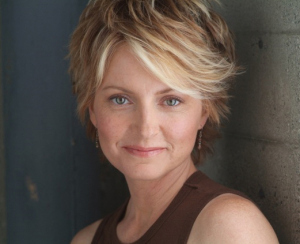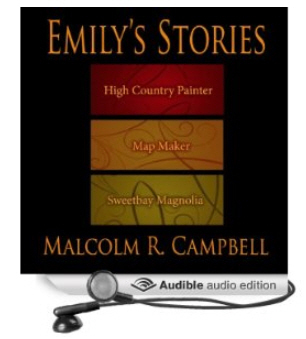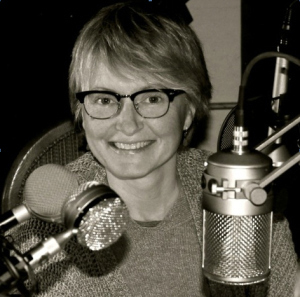Kelley Hazen: narrating a book can be ‘quite literally, transcendent’

Kelley Hazen
Today’s guest on Malcolm’s Round Table is Kelley Hazen, an artist who has appeared in multiple stage, screen and television productions. You may have seen her in “Nightingale in a Music Box,” “What Women Want,” and “Grey’s Anatomy.” She also lectures for the renowned Griffith Observatory in Los Angeles, CA.
Recently Kelley founded Storyteller Productions in Southern California with her husband, Bruce Carver. The boutique, state-of-the-art studio offers full recording services featuring intuitive narration. My three-story collection called Emily’s Stories, from Vanilla Heart Publishing, was Storyteller Productions fourth audio book.
Malcolm: When I listened to your narration of “Emily’s Stories,” I was reminded of my childhood when parents and grandparents read my favorite books to me on long, rainy afternoons and before I fell asleep at night. How do you achieve the being-there-with-the-listener effect?
Kelley: We have an amazing microphone – the vintage Sound Deluxe E49 – we selected that mic because of its perfect union with the timbre of my voice. As an artist and reader of audiobooks, I strive for a sense of…almost “sitting on the listener’s shoulder,” a quality of being in their heads, in their imaginations – a very intimate experience. I think when you combine that artistic goal with the technical mechanics of the right hardware you have the opportunity to create that sense of “being there with the listener.”
Malcolm: When you appear on the stage or work as a lecturer at the Griffith Observatory’s planetarium, there’s constant feedback from the audience. Is it difficult to change mindsets and figuratively work in a vacuum with voice-over work and audio book narration?
Kelley: No not at all, it’s actually strangely freeing because quite simply the story’s the thing. There is no hidden agenda, no coughing while I’m trying to make a point. : ) It’s just me, the mic, the story.
 Malcolm: Can you walk me through what a typical narration project includes beginning with the first time you see the book or printed manuscript through the final production of the audio file? How do you prepare?
Malcolm: Can you walk me through what a typical narration project includes beginning with the first time you see the book or printed manuscript through the final production of the audio file? How do you prepare?
Kelley: We’ve usually gotten a feel for the book or the writer by either submitting an audition or pitch for the book, or because we’ve dealt with the publisher or author before. So we’ve either seen excerpts or been able to ascertain some sense of who we are dealing with. We believe that often, if not always, artists (writers/actors/publishers & editors if they do their job fully) have an underlying sense of how they want to be perceived in the world, what message they are sending, how they want to impact the greater good. At Storyteller we try to embody that – after all we are a conduit to get across the message that the writer is trying to convey by gathering these particular words together in this way.
Malcolm: I like that approach. Once you grok the story and its message, what additional preparation do you have?
Kelley: Then we just start breaking it down – a chapter at a time. That’s why it is most helpful when an author can send us the manuscript in electronic form. Although I will say our last two books were old school – regular ‘ol page-turning bound books. And it was a welcome respite from iPad’s and Word docs. But we always need two copies because the engineer, my husband Bruce, follows along as I record to watch for missed or mis-spoken words, but also has his own notations as he works for the editing and clean up. So I take it a chapter at a time – realizing the story, assessing the number of characters and their demands, looking up words I don’t know, learning languages.

Pine Siskin
Our last two books – I learned fragments of three different languages and multiple dialects for the 25+characters in Petty Magic. For Maria of Agreda: Mystical Lady in Blue, a nonfiction about the life and efforts for canonization of a 17th century cloistered nun, I not only had to go to school to understand the Old World process of becoming a saint, but since the book was almost entirely set in Spain, accurate pronunciations of Kings, Viceroyalty, Popes, cities, mountain ranges, etc. were essential. For Emily’s Stories I found pictures of the birds that became such important characters for Emily and clips on YouTube by avid birders who had recorded the cry of each of these birds. Then when I gave the bird characters voices or imitated their calls, I tried to make it sound as much like that bird in real life as I was able. Also something just as simple as knowing where to take the breath to maintain the understanding of a line as it is read. All this work is done beforehand.
Malcolm: The pine siskin in my story “High Country Painter” thanks you! There’s more pre-narration work involved here than I imagined.

In the Studio
Kelley: Then we go into the studio and begin to record. We have to make sure that I don’t consume too much dairy so there is not too much phlegm to cause constriction in my voice. I have to eat so my stomach doesn’t growl. You would be amazed at what the intimacy of and the quality of these current day mics can pick up. It’s like HD for the ears. We usually record in two hours sessions. We can often do two session a day depending on our schedule. We keep separate files of snippets of new characters when they come along, once I’ve found their voice, so that when we come back to them I can hear how I did it the first time and keep it consistent. Consistency is key for the structure of a good audiobook.
Malcolm: Do you alternate the studio work and the preparation ?
Kelley: Anywhere from two to five chapters are prepped at a time. And during my prep time Bruce begins to edit. He listens to the whole thing all over again watching the book to look for missed words or times when I started again on a section but also any kind of outside noise or mouth noise or popping. He looks at an actual wave of my voice frequency–its in a program called Pro Tools. So he can hear but also see when extraneous sounds are present and cut them out or re EQ them by changing the sound around the errant noise. If I’ve missed anything or there is anything he can’t get out, we have a fix session.
[image error]



